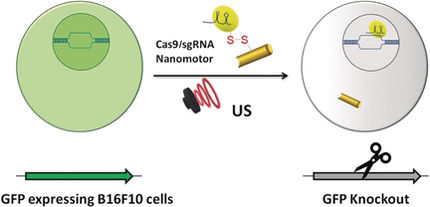Photoactivable bioluminescent probe
A group of scientists led by Bengang Xing, at Nanyang Technological University, Singapore, in collaboration with Zhen Cheng and colleagues at Stanford University Medical Centre, California, have developed a photoactivable bioluminescent probe for imaging luciferase activity in live cells.
Firefly luciferase has long been used as an optical reporter to monitor processes such as gene transfection. Usually the genes coding for the Luciferase protein are included with the gene of interest in gene therapy and transgenic model engineering experiments, leading to its expression in the target cells. These colonies of cells are then exposed to D-Luciferin, which is Luciferase's substrate. If the gene transfection has been successful this results in a bioluminescent signal, which can be viewed via a charge coupled device (CCD) camera.
To date, there have been many examples of photoactivable fluorescent probes, where the fluorophore is covalently attached to a 'cage' compound that quenches its fluorescence, until the molecule is irradiated with UV light. This irradiation causes the 'cage' molecule to dissociate from the fluorophore, allowing it to fluoresce. Xing and his team have applied this technology to the traditional Luciferase probe, conferring spatiotemporal control over the probe's signal.
Bioluminescent imaging offers several advantages over fluorescent imaging techniques including low background interference, as normal cells do not produce luminescence when undergoing conventional processes, making a bioluminescent probe's signal sensitive and easy to interpret.
In the past there have been difficulties obtaining successfully engineered photo-caged bioluminescent probes, however Xing's probe, which consists of D-Luciferin covalently modified at the 6- hydroxyl position, shows good membrane permeability and has already been successful in live animal models.
Xing hopes that this development will have implications for biological tomography, allowing the visual monitoring of biological processes such as cell trafficking, and is currently working on improving the platform combining it with two-photon photolysis, which would mean that a shorter excitation period would be able to be used to 'uncage' the D-Luciferin. Another benefit of making this platform amenable to two-photon photolysis is that the wavelength of light used is far less damaging than UV, and is not blocked by skin to the same extent, meaning that this optical reporter could have a bright future for non-invasive, live imaging of cellular events.
Original article: Bengang Xing et. al., Chem. Commun., 2009.
Other news from the department science
Most read news
More news from our other portals
See the theme worlds for related content
Topic world Gene therapy
Genetic diseases once considered untreatable are now at the center of innovative therapeutic approaches. Research and development of gene therapies in biotech and pharma aim to directly correct or replace defective or missing genes to combat disease at the molecular level. This revolutionary approach promises not only to treat symptoms, but to eliminate the cause of the disease itself.

Topic world Gene therapy
Genetic diseases once considered untreatable are now at the center of innovative therapeutic approaches. Research and development of gene therapies in biotech and pharma aim to directly correct or replace defective or missing genes to combat disease at the molecular level. This revolutionary approach promises not only to treat symptoms, but to eliminate the cause of the disease itself.



















































